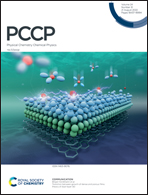[Fe4S4] cubane in sulfite reductases: new insights into bonding properties and reactivity†
Abstract
The dissimilatory sulfite reductase enzyme has very characteristic active site where the substrate binds to an iron site, ligated by a siroheme macrocycle and a thiol directly connected to a [Fe4S4] cluster. This arrangement gives the enzyme remarkable efficiency in reducing sulfite and nitrite all the way to hydrogen sulfide and ammonia. For the first time we present a theoretical study where substrate binding modalities and activation are elucidated using active site models containing proton supply side chains and the [Fe4S4] cluster. Density functional theory (DFT) was deployed in conjunction with the energy decomposition scheme (as implemented in AMS), the quantum theory of atoms in molecules (QTAIM), and conceptual DFT (cDFT) descriptors. We quantified the role of the electrostatic interactions inside the active site created by the side chains as well as the influence of the [Fe4S4] cluster on the substrate binding. Furthermore, using conceptual DFT results we shed light of the activation process, thus, laying foundation for further mechanistic studies. We found that the bonding of the ligands to the iron complex is dominated by electrostatic interactions, but the presence of the [Fe4S4] cubane leads to substantial changes in electronic interaction. The spin state of the cubane, however, affects the binding energy only marginally. The conceptual DFT results show that the presence of the [Fe4S4] cubane affects the reactivity of the active site as it is involved in electron transfer. This is corroborated by an increase in the electrophilicity index, thus making the active site more prone to react with the ligands. The interaction energies between the ligand and the siroheme group are also increased upon the presence of the cubane group, thus, suggesting that the siroheme group is not an innocent spectator but plays an active role in the reactivity of the dSIR active site.
![Graphical abstract: [Fe4S4] cubane in sulfite reductases: new insights into bonding properties and reactivity](/en/Image/Get?imageInfo.ImageType=GA&imageInfo.ImageIdentifier.ManuscriptID=D2CP02124B&imageInfo.ImageIdentifier.Year=2022)


 Please wait while we load your content...
Please wait while we load your content...
